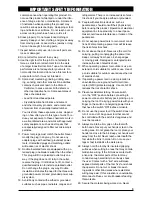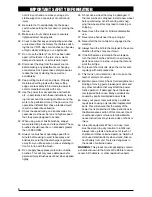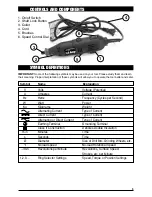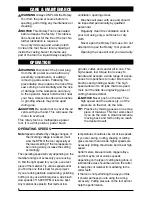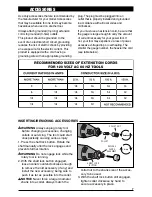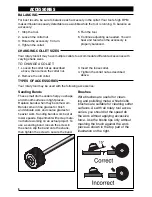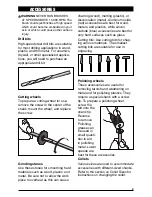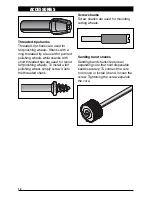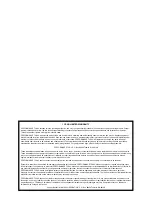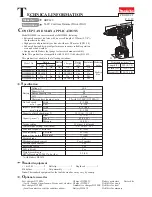
3
IMPORTANT SAFETY INFORMATION
common sense when operating this product. Do
not use this product while tired or under the influ-
ence of drugs, alcohol, or medication. A moment
of inattention while operating this product may
result in serious personal injury. Keep proper foot-
ing and balance at all times. Do not reach over or
across running machines, hoses, cords, etc.
6. Dress properly. Do not wear loose clothing or
jewelry. Keep your hair, clothing, and gloves away
from moving parts. Loose clothes, jewelry or long
hair can be caught in moving parts.
7. Inspect before every use; do not use if parts are
loose or damaged.
8. Do not alter this product in any way.
9. Use the right tool for the job. Do not attempt to
force a small tool or attachment to do the work
of a larger industrial tool. Don’t use a tool whose
performance is not adequate for your work. Do
not modify this tool and do not use this tool for a
purpose for which it was not intended.
10. Some dust created by grinding, drilling, saw-
ing, sanding, and other construction activities
contains chemicals known to the State of
California to cause cancer, birth defects or
other reproductive harm. Some examples of
these chemicals are:
• Lead from lead-based paints.
• Crystalline silica from bricks and cement
and other masonry products, and arsenic and
chromium from chemically-treated lumber.
Your risk from these exposures varies, depend-
ing on how often you do this type of work. To re-
duce your exposure to these chemicals: work in
a well ventilated area, and work with approved
safety equipment, such as dust masks that
are specially designed to filter out microscopic
particles.
11. Power tool plugs must match the outlet. Never
modify the plug in any way. Do not use any
adapter plugs with earthed (grounded) power
tools. Unmodified plugs and matching outlets
will reduce risk of electric shock.
12. Double insulated tools are equipped with a po-
larized plug (one blade is wider than the other.)
This plug will fit in a polarized outlet only one
way. If the plug does not fit fully in the outlet,
reverse the plug. If it still does not fit, contact a
qualified electrician to install a polarized outlet.
Do not change the plug in any way. Double
insulation eliminates the need for the three wire
grounded power cord and grounded power sup-
ply system.
13. Avoid body contact with earthed or grounded
surfaces such as pipes, radiators, ranges and
refrigerators. There is an increased risk of elec-
tric shock if your body is earthed or grounded.
14. People with electronic devices, such as
pacemakers, should consult their physician(s)
before using this product. Operation of electrical
equipment in close proximity to a heart pace-
maker could cause interference or failure of the
pacemaker.
15. Do not expose power tools to rain or wet condi-
tions. Water entering a power tool will increase
the risk of electric shock.
16. Do not abuse the cord. Never use the cord for
carrying, pulling or unplugging the power tool.
Keep cord away from heat, oil, sharp edges
or moving parts. Damaged or entangled cords
increase the risk of electric shock.
17. When operating a power tool outdoors, use an
extension cord suitable for outdoor use. Use of
a cord suitable for outdoor use reduces the risk
of electric shock.
18. If operating a power tool in a damp location is
unavoidable, use a ground fault circuit inter-
rupter (GFCI) protected supply. Use of a GFCI
reduces the risk of electric shock.
19. Prevent accidental starting. Ensure switch
is in the “OFF” position before connecting to
power source and/or battery pack, picking up or
carrying the tool. Carrying power tools with your
finger on the switch or energizing power tools
that have the switch “ON” invites accidents.
20. Do not use the power tool if the switch does not
turn it on and off. Any power tool that cannot
be controlled with the switch is dangerous and
must be repaired.
21. Always maintain a firm grip on the tool with
both hands. Never put your hands or feet in the
cutting area. Do not grasp the tool or place your
hands too close to the bit. Keep your hands well
away from the bit. Never reach underneath the
tool while the bit is in motion. Do not use your
legs or feet to stabilize the work piece.
22. Always hold the tool by its insulated gripping
surfaces when cutting in areas that may contain
hidden live wiring. If the bit makes contact with
a live wire, the metal parts of this tool may
conduct enough electricity to seriously shock
the user. Contact with a “live” wire will make
exposed metal parts of the tool “live” and shock
the operator. Do not cut or break into exist-
ing walls or other blind areas where electrical
wiring may exist. If this situation is unavoidable,
disconnect all fuses or circuit breakers feeding
this worksite.
23. Secure the material being worked on. Never
Summary of Contents for W50031
Page 11: ......



